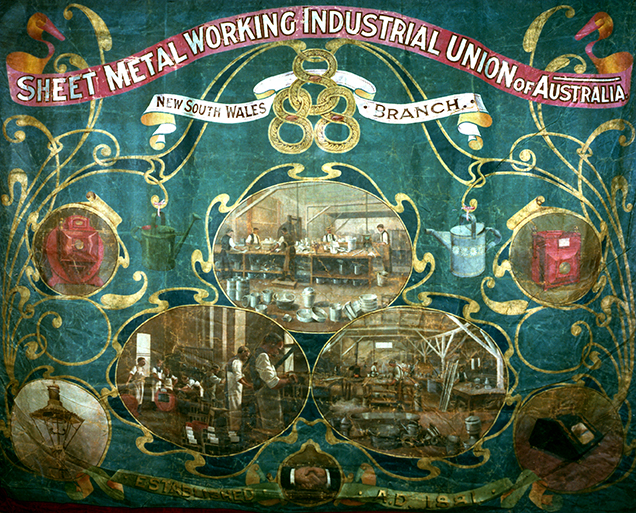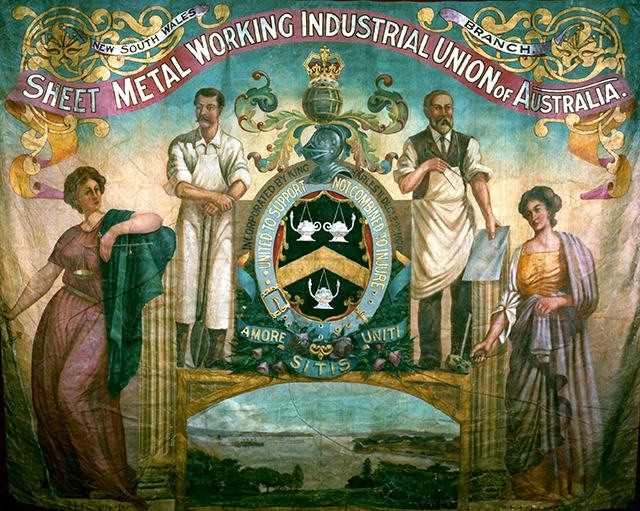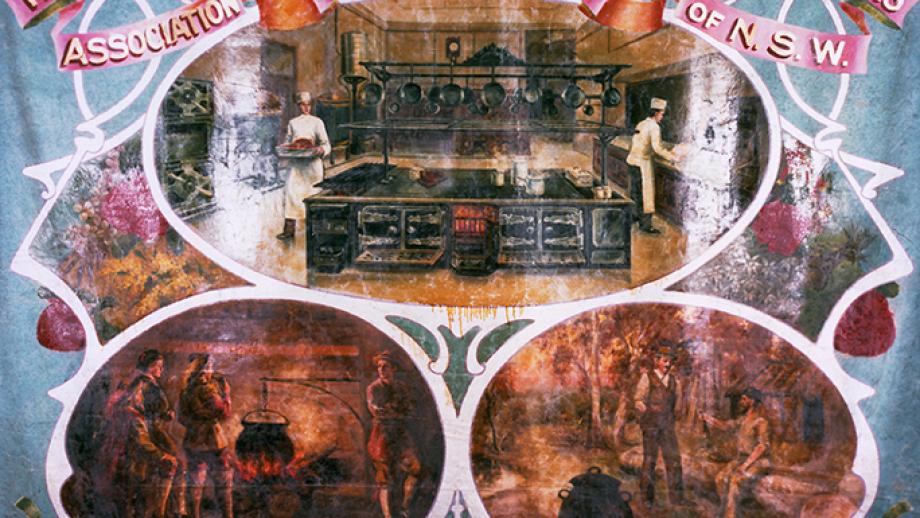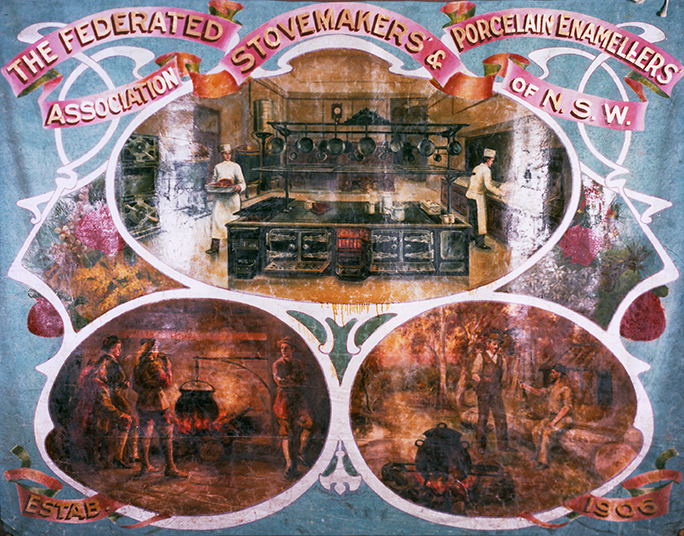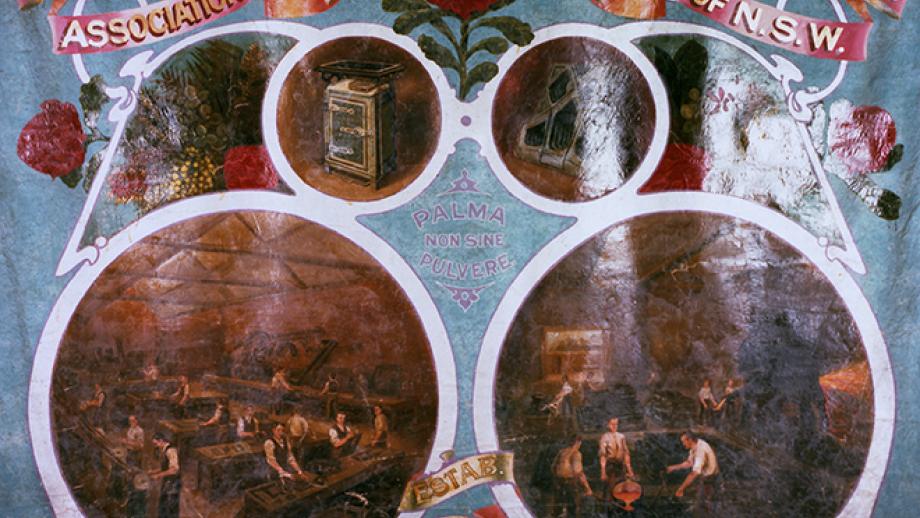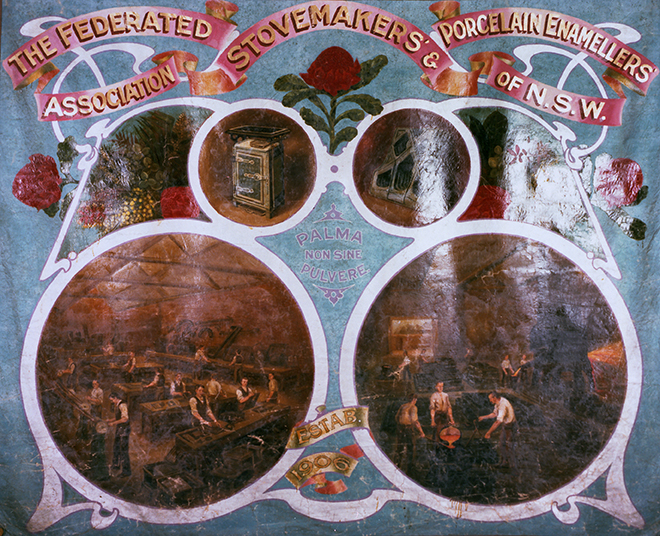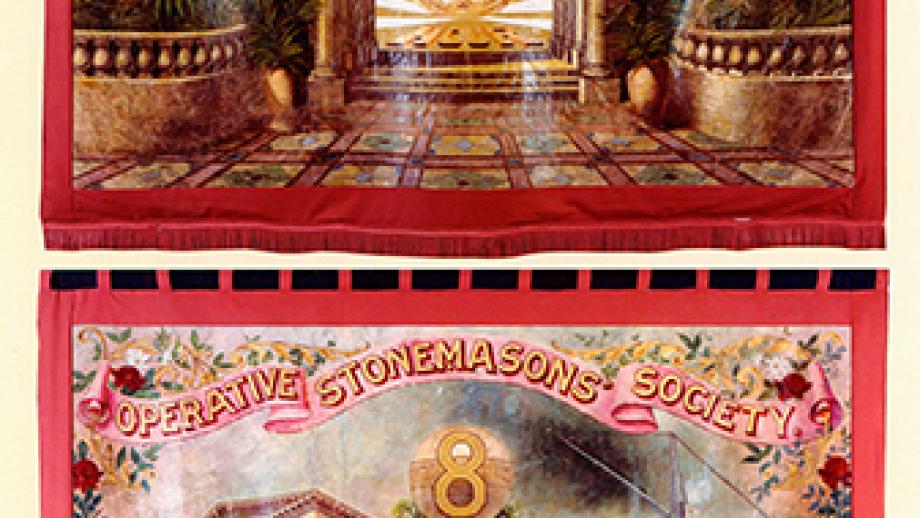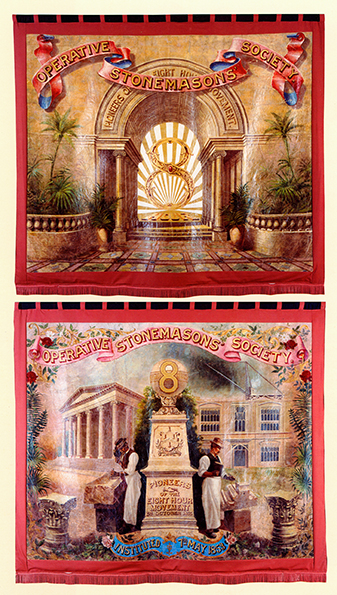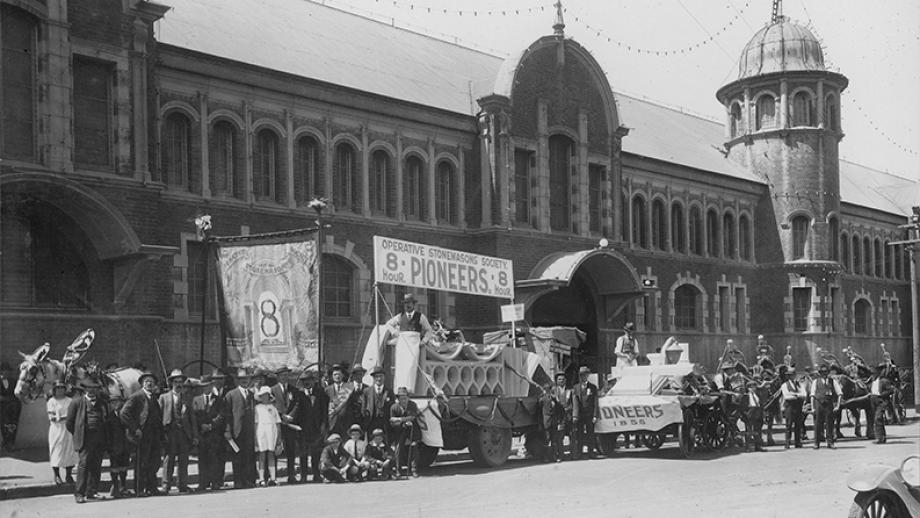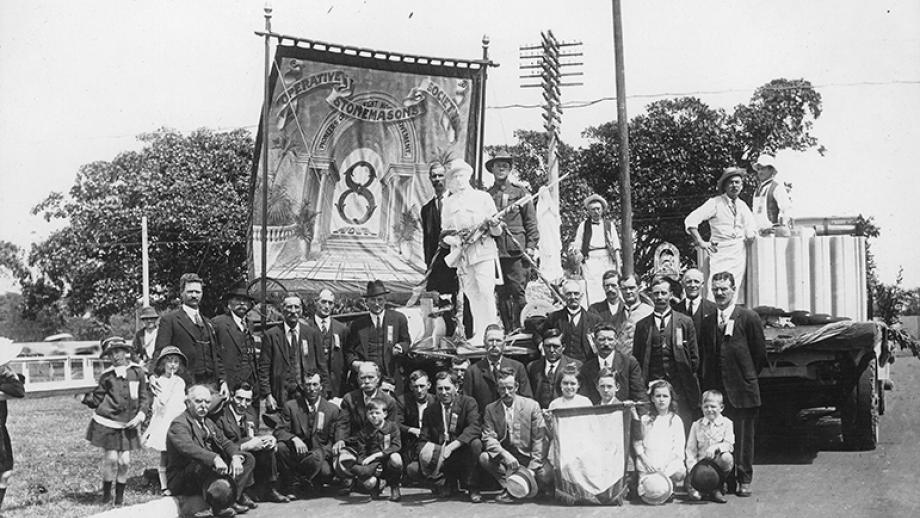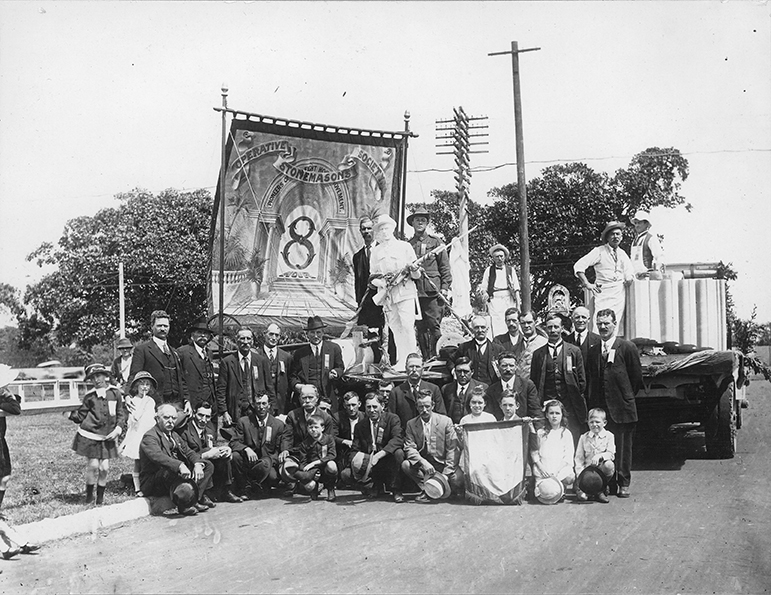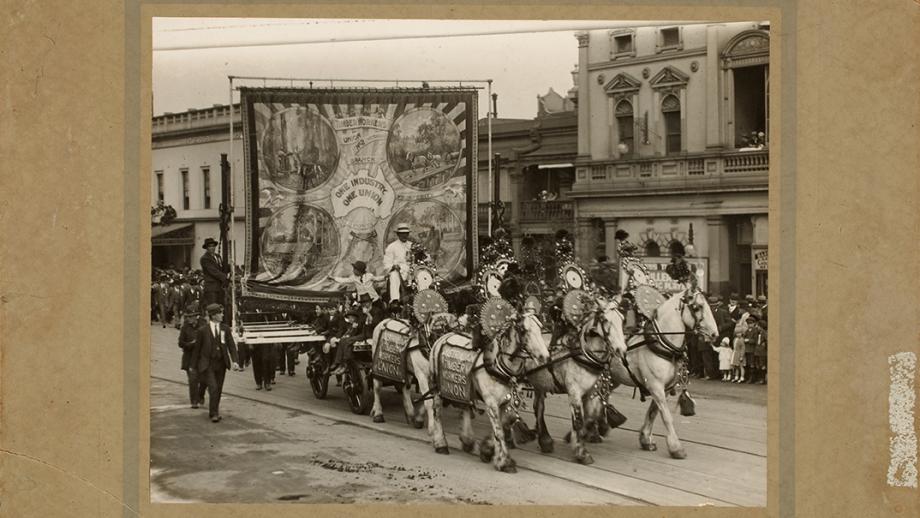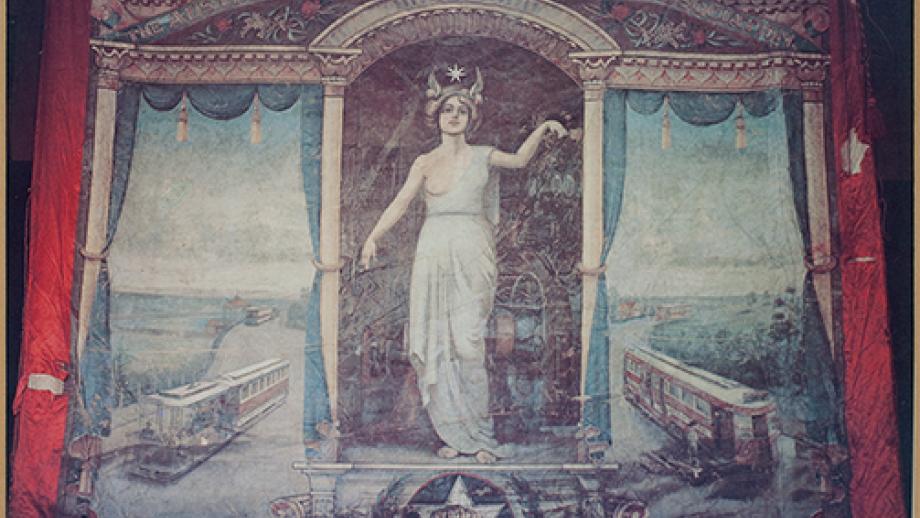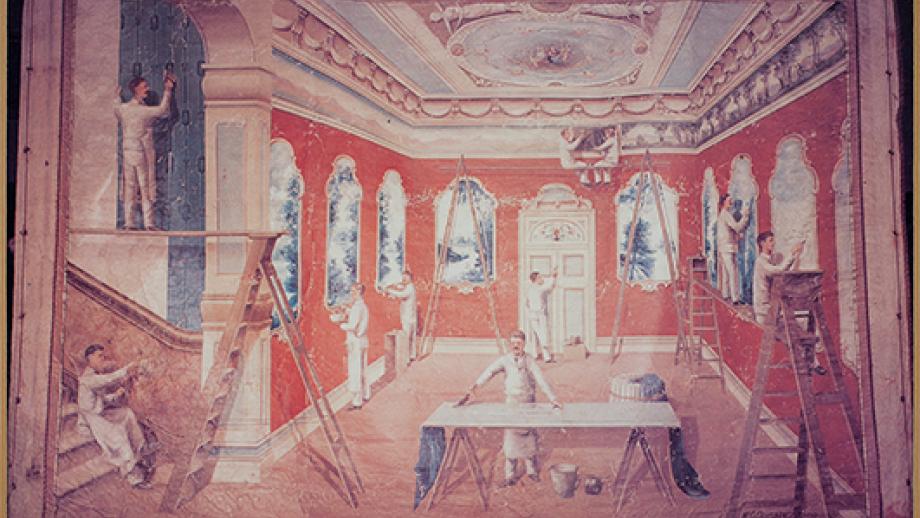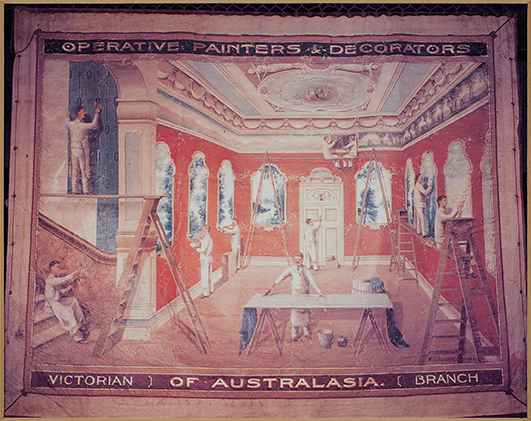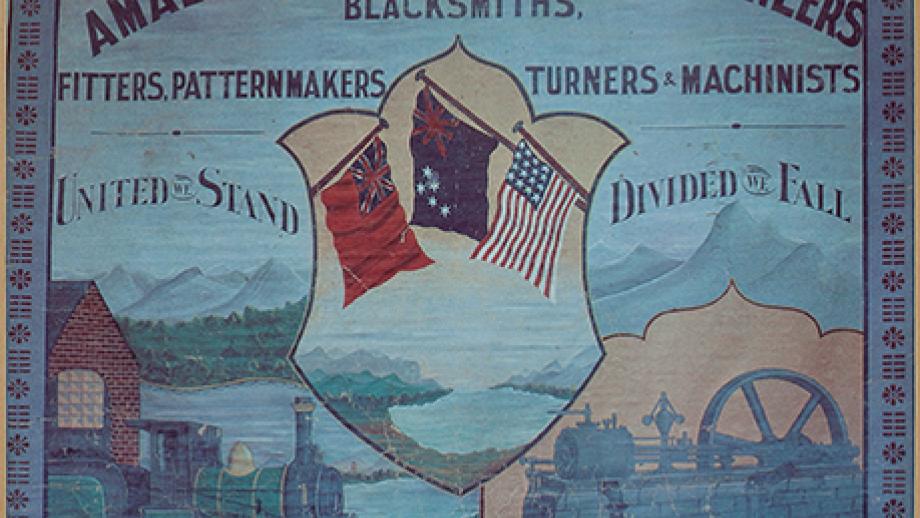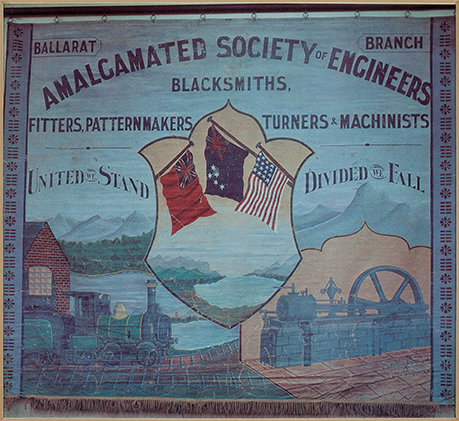Trade union banners
Design
For trade unionists, and many others in the community, banners are powerful symbols of the role played by unions in advancing the conditions and wages of working people. They were commissioned by particular unions to represent the collective identity of a trade and they became important declarations of legitimacy.
Banners were usually made from cotton or canvas and painted with bright colours. One side of the banner was usually a realistic depiction of the particular trade, including materials, tools and skills needed to carry it out, while the other side used allegorical figures, females in particular, and symbols brimming with classical allusions, medieval guild references, and heraldic symbols to represent the history and ideals of the trade. Australian references also appeared including the Eight Hour Day symbol of the entwined figure of eight, indigenous flora and fauna and the coats of arms of Australian colonies.
From the 1900s images of local public buildings or landmarks and the celebration of Federation also became popular. Slogans underlined themes of unity, for example, 'United Throughout the World' and ‘Unity is Strength’.
In Australia banners only appeared in public on Eight Hour (Labour) Day. This contrasts with their British counterparts, which were used in strikes and demonstrations supporting progressive causes. While the original Eight Hour Day banner was made of bunting, most of the early banners were either silk or calico. These were vulnerable to the weather and many were reportedly destroyed by high winds. More robust canvas banners became common from the 1890s.
Most banners were approximately three metres by four metres and, being too large and too heavy to be carried by hand, they were mounted on horse-drawn carriages or floats. In later years they were transported by motorcade.
Key to Symbols
bundles of sticks - strength in unity: a single stick is easily broken but a bundle cannot be destroyed
clasped hands - mutual help and friendship
flags and the globe - international ties
historical and biblical figures associated with craft skills or industry – to add legitimacy to a trade (The printers depicted Caxton, for example, and the carpenters, Joseph of Nazarene.)
men in uniform - as symbols of their work
women - allegorical representations of countries or of virtues such as truth, justice and peace
work processes, workshops, tools and machinery - as documentary images of work
entwined triple figure of 8 - eight hours of work, eight hours of recreation, eight hours of rest
Banners
A and B - Sheet Metal Working Industrial Union of Australia, NSW Branch, 1919 (sides 1 & 2)
Source: Sheet Metal Working Industrial Union of Australia Sheet Metal Working Industrial Union of Australia, E245-211
C and D - Federated Stovemakers' & Porcelain Enamellers' Association of NSW, 1935 (sides 1 &2)
Source: Federated Stovemakers' & Porcelain Enamellers' Association, E245-212
E - Amalgamated Society of Carpenters & Joiners, Victorian Branch
Source: Photographs of Trade Union banners, N161/5
Painted on canvas in 1914 by W.G. Dunstan on one side allegorical figures representing Victoria, the United States, New Zealand and Canada act as handmaids to Britannia above the slogan 'United Throughout the World.' The main Australian imagery is the entwined figures of eight representing the Australian demand for an Eight Hour Day. On the other side Dunstan depicts the membership certificate of the Carpenters and Joiners, designed in 1868 by William Warby, illustrating many aspects of the work of carpenters and joiners, including bridge building, education, and house construction. Saint Joseph, given prominence as a significant carpenter, is seated above the Society's coat of arms, granted to the London Guild in 1466.
F - Operative Stonemasons’ Society of Australia, Sydney
Image reproduced from Trades Hall 1871-2007. Neale Towart (ed). Sydney : Unions NSW, 2007
On one side of the Operative Stonemasons’ Society of Australia’s Sydney banner two local buildings, the Art Gallery of New South Wales (left) and Sydney University’s Great Hall (right), display the skills of the craft. Framing the monument to the Eight Hour Day are two stonemasons, dressed in hat, tie, waistcoat and white apron - a stonemason’s work clothes of the time. On the other side of the banner a large symbolic ‘8’ represents the shorter working hours campaigns of 1856.
G - Operative Stonemasons' Society’s float, Labour Day, Sydney, 1921
The stonemasons are noted as being the first organised group of workers anywhere in the world to achieve the 8-hour working day with no loss in pay. Posing outside the Royal Agricultural Society’s Sydney showground, prior to a Labour Day parade in 1921, the Stonemasons’ contingent displays two banners that proudly affirm its Society’s achievement.
Source: Operative Stonemasons' Society of Australia, T46/32/7 (K3814)
H - Operative Stonemasons' Society’s float, Labour Day, Sydney, ca. 1918
The large symbolic ‘8’, featured predominantly in the centre of the banner, represents the shorter working hours campaigns of 1856.
Source: Operative Stonemasons' Society of Australia, E86/30/3 (K2169);
I - Operative Stonemasons’ Society’s banner, Labour Day, Sydney, ca. 1918
Source: Operative Stonemasons’ Society of Australia, E86/30/4
J - Australian Timber Workers’ float, Labour Day, Melbourne, 1921
This highly decorated Victorian Timber Workers’ banner reflects the influence of such socialists as John Curtin, Secretary of the Victorian Branch of the Australian Timber Workers Union, 1911-1915, and Prime Minister of Australia, 1941-1945. An active member of the Victorian Socialist Party prior to the First World War, Curtin was one of many unionists attracted by the possibilities of the One Big Union movement and committed to union reorganisation, as the banner’s slogan ‘One Industry, One Union’ testifies. Cameos at each corner of the banner illustrate the different phases of timber production: tree-felling in the bush, hauling logs to the mill along a bush tramway, cutting logs in a sawmill and removal by rail to metropolitan markets. The central map of Australia supported by a radiating pattern of light suggests that this may have been the work of a Melbourne banner painter named Hennessey, who used a similar design on a banner for the Victorian Railways Union.
Source: Australian Timber Workers Union, T34/5/4 (K4028)
K - Australian Tramway Employees’ Association, Victorian Branch (George Grant, 1916). Source: Photographs of Trade Union banners, N161/1
L - Australian Boot Trade Employees’ Federation, New South Wales Branch (Edgar Whitbread, ca. 1905). Source: Photographs of Trade Union banners, N161/2
M - Operative Painters & Decorators of Australia, Victorian Branch (W. Dunstan, 1915). Source: Photographs of Trade Union banners, N161/3
N - Amalgamated Society of Engineers, Blacksmiths, Fitters, Patternmakers, Turners & Machinists, Ballarat Branch (Kift & Smith, 1890). Source: Photographs of Trade Union banners, N161/4

